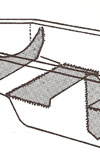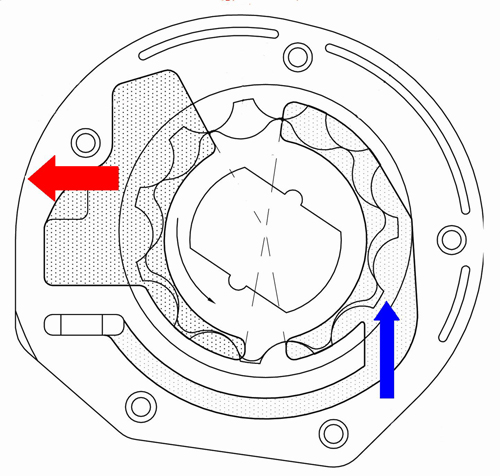The Gerotor Pump
 Last month we looked very briefly at gear pumps, in particular, external gear pumps when two gears sit side-by-side. A particular derivation of the gear pump however, sometimes referred to as an internal gear pump or internal-external gear pump is when one external gear fits inside a rotor consisting of an internal gear. With the centres of each gear offset from one another and a differing number of teeth on each of the gears, rather like its external counterpart, the resulting cavities can be made to pump fluids. A specialised form of this design which, rather than using an involute tooth profile it uses a slightly simpler one, is the gerotor pump.
Last month we looked very briefly at gear pumps, in particular, external gear pumps when two gears sit side-by-side. A particular derivation of the gear pump however, sometimes referred to as an internal gear pump or internal-external gear pump is when one external gear fits inside a rotor consisting of an internal gear. With the centres of each gear offset from one another and a differing number of teeth on each of the gears, rather like its external counterpart, the resulting cavities can be made to pump fluids. A specialised form of this design which, rather than using an involute tooth profile it uses a slightly simpler one, is the gerotor pump.
The ‘gerotor’ pump is a more recent introduction to the automotive world. Although its basic design concept goes back to the beginning of the 19th century, the ‘GeRotor’ principal (derived from combining the words GEnerating and ROTOR) consists primarily of two elements; an inner and an outer rotor. Designed using a trochoidal inner rotor from which the outer rotor is developed, the inner has one less tooth than the corresponding outer while at the same time the centrelines of each run at a fixed eccentricity. Rotating about their respective axes the chamber volume between the two rotors increases and then decreases which when linked to crescent shaped ports, can be used to pump fluids. Having been around quite some time, the automotive business didn’t fully appreciated its advantages until the early 1980s such that today it is perhaps the most commonly found oil pump type available.

Unlike the internal gear pumps mentioned at the start, the gerotor pump has no crescent shaped divider. The shape of the lobes is such that the surfaces of each are always at a tangent to and almost touching that of the lobe opposing it and in sliding contact with it. This, it is claimed, keeps an oil seal between the two elements and prevents backwards slippage as the oil progresses through the pump. A major advantage to this kind of pump over previous oil pump designs is one of packaging and the reduced pressure fluctuations in the delivery port. As engines are moving towards crankshaft triggered ignition and no longer requiring a distributor, oil pumps running directly from the nose of the crankshaft were more desirable. The flexibility of the design and the reduced costs of manufacturing (using netshaping techniques) also proved very attractive. Furthermore, the opening and closing of the intake and delivery ports over much longer periods than gear pump designs, is less likely to introduce turbulence and cavitation at higher engine speeds. For this reason gerotor pumps are often more popular in high speed engines.
Where space is limited and large amounts of air could be entrained in the oil, lobe pumps may be considered. A rather special case of a trochoidal rotor and based on a design similar to that of the Roots-type supercharger, two lobes when rotating together offer a much increased displacement for the same installed volume. Unlike any other trochoidal system the lobes have to be geared together separately and do not touch, but despite this large amounts of air/oil mixture can be easily handled at small pressure differences. This makes them excellent for use in oil scavenge systems. Difficult to make and highly sensitive to the clearances between lobes, these are not a popular solution.
Written by John Coxon.